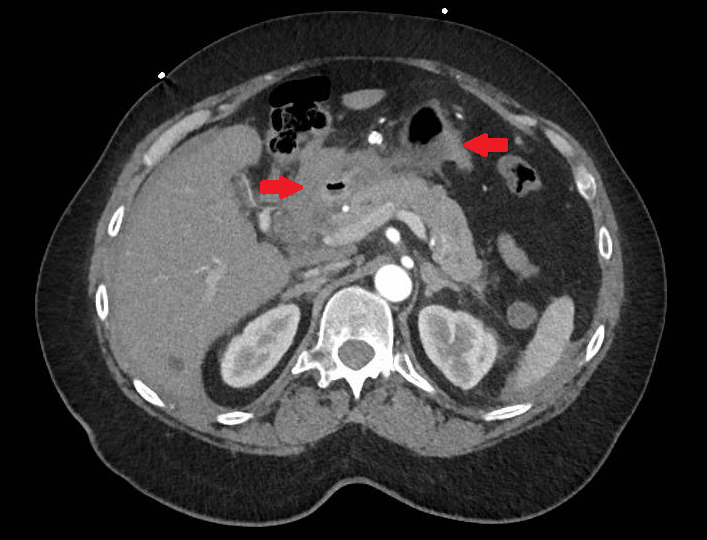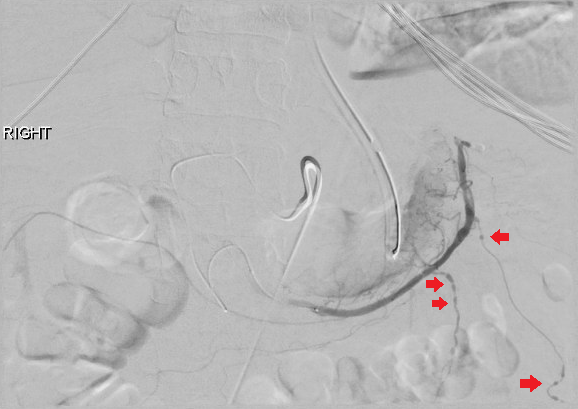Tuesday Poster Session
Category: Stomach and Spleen
P6361 - A Rare Case of Segmental Arterial Mediolysis Presenting as Gastric Outlet Obstruction in the Setting of Perigastric and Periduodenal Hematoma
Tuesday, October 28, 2025
10:30 AM - 4:00 PM PDT
Location: Exhibit Hall

Obada Daaboul, MD
Southern Illinois University
Springfield, IL
Presenting Author(s)
Obada Daaboul, MD, Muhammed Yaman Swied, MBBS, Muaataz Azzawi, MD, Zafar Quader, MD
Southern Illinois University, Springfield, IL
Introduction: Segmental arterial mediolysis (SAM) is an extremely rare and often misdiagnosed condition. It features nonatherosclerotic, noninflammatory arteriopathy with lysis and vacuolization of the arterial media, causing aneurysm, dissection, stenosis, or rupture. It primarily involves splanchnic arteries (celiac, mesenteric, and renal) and may present with acute abdominal pain from hemorrhage or ischemia or be incidentally detected on imaging. We report a rare case of SAM presenting with gastric outlet obstruction in the setting of perigastric and periduodenal hematoma.
Case Description/
Methods: A 62-year-old female presented to the emergency department with epigastric pain, nausea, and hematemesis. Physical exam was consistent with moderate abdominal tenderness without peritoneal signs. Laboratory results indicated a 4 g drop in hemoglobin. Abdominal computed tomography showed a large hematoma surrounding the distal stomach and the proximal duodenum. Given these findings, interventional radiology performed celiac, mesenteric, and bilateral renal angiograms, revealing numerous aneurysms affecting the pancreaticoduodenal arcade, as well as the duodenal, omental, right colic, and left renal arteries. Successful coil embolization of the gastroepiploic, superior pancreaticoduodenal, and gastroduodenal arteries was performed. Imaging findings, along with negative inflammatory markers, supported the diagnosis of SAM. An esophagogastroduodenoscopy was subsequently performed to evaluate symptoms of gastric outlet obstruction and revealed only erythematous gastric mucosa. The patient was managed conservatively, leading to the resolution of her symptoms. She was discharged with a plan for follow-up with vascular surgery.
Discussion: The diagnosis of SAM is challenging and often requires exclusion of vasculitis, fibromuscular dysplasia, and other vascular disorders. It is based on characteristic imaging findings and clinical context. Vasculitis and inflammatory markers were negative in our patient. Her symptoms were likely due to transient gastric outlet obstruction from a perigastric and periduodenal hematoma caused by SAM. SAM is a rare but significant vascular pathology to consider in cases of unexplained, severe, or recurrent hemorrhage, especially when imaging shows arterial abnormalities with perigastric or periduodenal hematoma. This case highlights the importance of including SAM in the differential diagnosis for patients with gastric outlet obstruction and arterial abnormalities on imaging.

Figure: Axial cross-section of abdominal computed tomography scan showing perigastric and periduodenal hematoma (red arrows).

Figure: Angiographic image demonstrating multiple small saccular and fusiform aneurysms (red arrows) involving the pancreaticoduodenal arcade.
Disclosures:
Obada Daaboul indicated no relevant financial relationships.
Muhammed Yaman Swied indicated no relevant financial relationships.
Muaataz Azzawi indicated no relevant financial relationships.
Zafar Quader indicated no relevant financial relationships.
Obada Daaboul, MD, Muhammed Yaman Swied, MBBS, Muaataz Azzawi, MD, Zafar Quader, MD. P6361 - A Rare Case of Segmental Arterial Mediolysis Presenting as Gastric Outlet Obstruction in the Setting of Perigastric and Periduodenal Hematoma, ACG 2025 Annual Scientific Meeting Abstracts. Phoenix, AZ: American College of Gastroenterology.
Southern Illinois University, Springfield, IL
Introduction: Segmental arterial mediolysis (SAM) is an extremely rare and often misdiagnosed condition. It features nonatherosclerotic, noninflammatory arteriopathy with lysis and vacuolization of the arterial media, causing aneurysm, dissection, stenosis, or rupture. It primarily involves splanchnic arteries (celiac, mesenteric, and renal) and may present with acute abdominal pain from hemorrhage or ischemia or be incidentally detected on imaging. We report a rare case of SAM presenting with gastric outlet obstruction in the setting of perigastric and periduodenal hematoma.
Case Description/
Methods: A 62-year-old female presented to the emergency department with epigastric pain, nausea, and hematemesis. Physical exam was consistent with moderate abdominal tenderness without peritoneal signs. Laboratory results indicated a 4 g drop in hemoglobin. Abdominal computed tomography showed a large hematoma surrounding the distal stomach and the proximal duodenum. Given these findings, interventional radiology performed celiac, mesenteric, and bilateral renal angiograms, revealing numerous aneurysms affecting the pancreaticoduodenal arcade, as well as the duodenal, omental, right colic, and left renal arteries. Successful coil embolization of the gastroepiploic, superior pancreaticoduodenal, and gastroduodenal arteries was performed. Imaging findings, along with negative inflammatory markers, supported the diagnosis of SAM. An esophagogastroduodenoscopy was subsequently performed to evaluate symptoms of gastric outlet obstruction and revealed only erythematous gastric mucosa. The patient was managed conservatively, leading to the resolution of her symptoms. She was discharged with a plan for follow-up with vascular surgery.
Discussion: The diagnosis of SAM is challenging and often requires exclusion of vasculitis, fibromuscular dysplasia, and other vascular disorders. It is based on characteristic imaging findings and clinical context. Vasculitis and inflammatory markers were negative in our patient. Her symptoms were likely due to transient gastric outlet obstruction from a perigastric and periduodenal hematoma caused by SAM. SAM is a rare but significant vascular pathology to consider in cases of unexplained, severe, or recurrent hemorrhage, especially when imaging shows arterial abnormalities with perigastric or periduodenal hematoma. This case highlights the importance of including SAM in the differential diagnosis for patients with gastric outlet obstruction and arterial abnormalities on imaging.

Figure: Axial cross-section of abdominal computed tomography scan showing perigastric and periduodenal hematoma (red arrows).

Figure: Angiographic image demonstrating multiple small saccular and fusiform aneurysms (red arrows) involving the pancreaticoduodenal arcade.
Disclosures:
Obada Daaboul indicated no relevant financial relationships.
Muhammed Yaman Swied indicated no relevant financial relationships.
Muaataz Azzawi indicated no relevant financial relationships.
Zafar Quader indicated no relevant financial relationships.
Obada Daaboul, MD, Muhammed Yaman Swied, MBBS, Muaataz Azzawi, MD, Zafar Quader, MD. P6361 - A Rare Case of Segmental Arterial Mediolysis Presenting as Gastric Outlet Obstruction in the Setting of Perigastric and Periduodenal Hematoma, ACG 2025 Annual Scientific Meeting Abstracts. Phoenix, AZ: American College of Gastroenterology.
